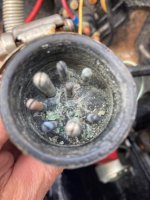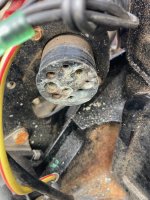johnnyseko
New member
*Reposting in the correct forum...
Just joined to try to get some more insight into my unresolved problem - and hopefully post positive results after repair.
My 1988 Cobia Monte Carlo is giving me a headache -
Starts fine, idles fine and I can idle out of the no wake zone no issues. Run it up to @3000rpm, running great and then within 5 minutes will sputter and stall. Will restart, but will not go above idle without stalling again. Then while idling back to the dock will run for approx 5min before stalling again. Then have to allow to cool for a few minutes and it will start and idle, repeating the process until I get back to the dock (This cycle went on for about 6 stalls/restarts until I got to the dock). Verified this issue over multiple days while trying to repair.
This problem suddenly appeared after running fine for the last season and beginning of this one. I thought for sure a fuel issue as it occurred same day I had just topped it off at the marina and we had gotten a ton of rain just prior. Here is the current work I've done so far and it still isn't fixed -
-New Fuel lines
-Cleaned and straightened breather line (there was a low spot collecting fuel I eliminated)
-New anti siphon valve
-Emptied gas tank and refilled with fresh fuel from marina
-Added new water separator housing and filter
-Changed fuel filter at fuel pump
-Cleaned filter at carb inlet
-Cleaned air filter/flame arrestor and checked butterfly for proper movement
-New condenser
-New spark plugs
-New ignition coil
Also, in 2021 I rebuilt the carb. New points, rotor and condenser. New fuel pump. Adjusted the timing. Was running fine since that work was done. Also new spark plug wires 2022.
Not really sure where to go from here (besides a real mechanic). Seems like an electrical issue when it gets hot? I did double check the temps with an IR temp gun and nothing is out of the ordinary and all engine gauges are good when running.
Thanks for your time.
**I've since just brought it to the mechanic. We'll see what he says. I ran it over to the marina @ 1000rpm and it took just under an hour to get there. Didn't have an issue at all and it killed me not to try to get it up on plane...
Just joined to try to get some more insight into my unresolved problem - and hopefully post positive results after repair.
My 1988 Cobia Monte Carlo is giving me a headache -
Starts fine, idles fine and I can idle out of the no wake zone no issues. Run it up to @3000rpm, running great and then within 5 minutes will sputter and stall. Will restart, but will not go above idle without stalling again. Then while idling back to the dock will run for approx 5min before stalling again. Then have to allow to cool for a few minutes and it will start and idle, repeating the process until I get back to the dock (This cycle went on for about 6 stalls/restarts until I got to the dock). Verified this issue over multiple days while trying to repair.
This problem suddenly appeared after running fine for the last season and beginning of this one. I thought for sure a fuel issue as it occurred same day I had just topped it off at the marina and we had gotten a ton of rain just prior. Here is the current work I've done so far and it still isn't fixed -
-New Fuel lines
-Cleaned and straightened breather line (there was a low spot collecting fuel I eliminated)
-New anti siphon valve
-Emptied gas tank and refilled with fresh fuel from marina
-Added new water separator housing and filter
-Changed fuel filter at fuel pump
-Cleaned filter at carb inlet
-Cleaned air filter/flame arrestor and checked butterfly for proper movement
-New condenser
-New spark plugs
-New ignition coil
Also, in 2021 I rebuilt the carb. New points, rotor and condenser. New fuel pump. Adjusted the timing. Was running fine since that work was done. Also new spark plug wires 2022.
Not really sure where to go from here (besides a real mechanic). Seems like an electrical issue when it gets hot? I did double check the temps with an IR temp gun and nothing is out of the ordinary and all engine gauges are good when running.
Thanks for your time.
**I've since just brought it to the mechanic. We'll see what he says. I ran it over to the marina @ 1000rpm and it took just under an hour to get there. Didn't have an issue at all and it killed me not to try to get it up on plane...




